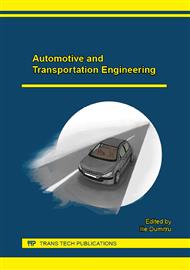[1]
R. S. Berkof, The Input Torque in Linkages, Mechanism and Machine Theory. 14 (1979) 61 – 73.
DOI: 10.1016/0094-114x(79)90042-9
Google Scholar
[2]
S. C. Chapra, R. P. Canale, Numerical Methods for Engineers with Programming and Software Applications, 3rd Edition, Mcgraw-Hill, USA: New York, (1998).
Google Scholar
[3]
W. Cheney, D. Kincaid, Numerical Mathematics and Computing, 4th Edition, Brooks and Cole publishing Company, USA: New York, (1999).
Google Scholar
[4]
C. Alexandru, Aspects regarding the wiper windshield mechanism analysis by considerrig as multibody systems, Annals of the University of Oradea, Fascicle of Management and Tech. Eng., V (XV) (2006). 591-600.
Google Scholar
[5]
A. Zuhair, Contributions regarding the finite element analysis of deformable kinematic linkages with applications on automotive industry, PhD Thesis. Craiova, (2009).
Google Scholar
[6]
C.O. Izelu, Analysis of Rocker Mechanism for Automobile Windscreen Wiper Applications, Journal of Innovative Research in Engineering and Science, 1(1) (2010) 13-54.
Google Scholar
[5]
C. Copilusi, M. Ceccarelli, G. Carbone, Design and Numerical Characterization of a New Leg Exoskeleton for Motion Assistance. Robotica Cambridge University Press (2014) 1-16.
DOI: 10.1017/s0263574714002069
Google Scholar
[7]
C. Copiluşi, M. Ceccarelli, N. Dumitru, G. Carbone. Design and Simulation of a Leg Exoskeleton Linkage for a Human Rehabilitation System. Mechanisms and Machine Science, 18. Ed. Springer. (2013) 107-115.
DOI: 10.1007/978-3-319-01845-4_12
Google Scholar
[8]
C. Copiluşi, M. Ceccarelli, G. Carbone, A. Margine. Mechanism of a Leg Exoskeleton for Walking Rehabilitation Purposes. New Advantages in Mechanisms, Transmissions and Applications. Ed. Springer. (2013) 117-125.
DOI: 10.1007/978-94-007-7485-8_14
Google Scholar
[9]
N. Dumitru, Fundamentals of Modelling the Mechanical Systems. Editura Universitaria Publishing House. Craiova, (2002).
Google Scholar
[10]
N. Dumitru, G. Nanu, Mechanisms and Mechanical Transmissions, Bucharest Publishing house, (2008).
Google Scholar
[11]
S. Rajasekaran, Numerical methods in Science and Engineering: A Practical Approach, S. Chand and Company Ltd, Ram Nagar, India: New Delhi, (2003).
Google Scholar
[12]
J. Giesbers, Contact Mechanics in MSC ADAMS. A technical evaluation of the contact models in multibody dynamics software MSC Adams. Bachelor Thesis. University of Twente, (2012).
Google Scholar
[13]
MSC Adams User Manual, (2012).
Google Scholar


